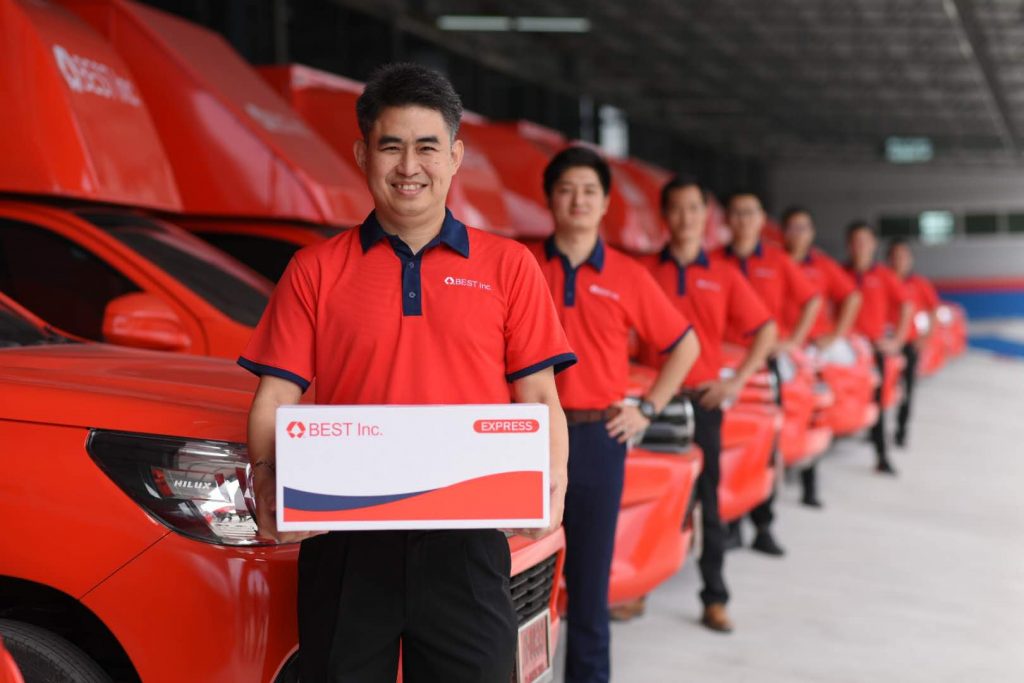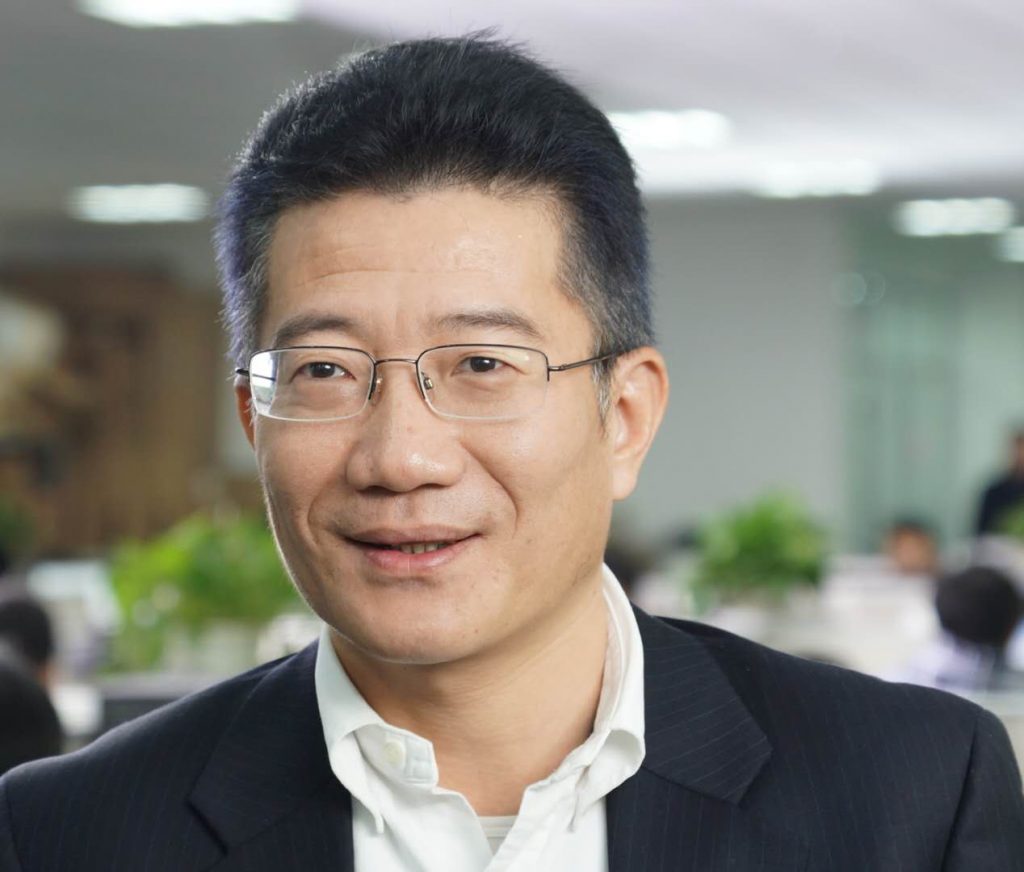Pongthorn Laohavilai is a franchisee of Chinese logistics company Best (NYSE: BEST) in Thailand, and employs 30 couriers to serve consumers around the Navamin center in the country’s capital, Bangkok. His parcel delivery business has quickly grown in less than two years, so he had to recently expand his distribution center in Navamin from 250 square meters to over 650 square meters.
He told KrASIA that 2019 was perfect timing for him to join Best’s network as one of the first franchisees to capitalize on Thailand’s rapidly growing logistics market. In the second quarter of 2020 alone, couriers wearing Best Express uniforms delivered 10 million parcels in Thailand, which represents a nearly 100% increase from the first quarter, in a country with a population of about 70 million people.
KrASIA recently sat down with Best’s founder and chairman Shao-Ning Johnny Chou, along with two of the company’s employees, to understand the firm’s rise and future plans.

How a late entrant captured over 10% of the market
Chou, born in 1962 in Ningbo, East China’s Zhejiang province, resigned from his position as Google’s president for Greater China in 2016 and founded Best in 2007 in Hangzhou, capital of Zhejiang province.
Right after launch, Best established a research and development division in charge of developing a cloud-based supply chain management software platform, and in 2008, it started to offer customized supply chain management solutions, including warehouse management, inventory planning, and transportation, to companies including sportswear maker Li-Ning and casualwear maker Metersbonwe.
In 2010, Best acquired Huitong Express and officially entered into the express delivery sector, where it found strong competitors in the likes of SF Express (SHZ: 002352) launched in 1993 in Shenzhen, STO Express (SHZ: 002468), also set up in 1993 in Hangzhou, and other companies like Yunda (SHZ: 002120), YTO Express (SHH: 600233), and ZTO Express (NYSE: ZTO), all vying for market share.
Despite being a latecomer, Best, which raised USD 15 million in a Series A financing from Alibaba and Foxconn in 2008, witnessed a 93% compound annual growth rate between 2012 and 2016, when it delivered 2.2 billion parcels, up from 200 million in 2012. Correspondingly, the company’s market share in the Chinese express delivery sector increased from 2.7% in 2012 to 6.9% in 2016.
“We have been riding the upward wave of e-commerce in China,” said Chou, attributing Best’s rise to “being into the right trend.” Best’s market share in China further increased to 9.4% in 2017, 10.8% in 2018, and to 11.9% in 2019.
New technologies and a light-asset franchisee model have also been reasons for Best’s fast growth, he added. “It is impossible for a company to handle tens of millions of parcels daily without technology.”
Chou said Best has been leveraging automation technologies to increase efficiency, adding that the company was the first among all Chinese logistics firms to apply automatic sorting machines, which Best developed in-house. The firm’s automatic sorting systems, powered by technologies including big data analysis and image processing, started to be used across all the firm’s sorting centers nationwide as early as 2013, increasing the accuracy of sorting to 99.9% from 80%, the average rate for humans, according to information provided by Best.
Best has also applied an outsourcing strategy to its business. The firm outsources line-haul transportation on highways to other providers, while it has set up a network of franchisee partners for last-mile delivery. Partners are in charge of renting brick-and-mortar locations to store daily parcels, hire couriers, and seek e-commerce vendors or other clients to increase transaction volume.
Copying the growth model strategy experienced in China to Southeast Asia

After witnessing quick growth in China, Best identified Southeast Asia as the next region to seek expansion. The company started to offer express delivery services in Thailand in early 2019 and in Vietnam in October of the same year. Boosted by encouraging performances in these two countries, Best ventured into Malaysia, Cambodia, and Singapore in the second quarter of this year. The firm delivered a total of 16.1 million parcels in these five countries in the second quarter of 2020, up 1,955% compared with the same quarter of 2019.
In Vietnam, Best is now a logistics service supplier for e-commerce platforms including Lazada, Shopee, Sendo, and Tiki. The company is also a supplier for Lazada and Shopee in Thailand, as well as Kasikorn Bank, while it has sought to replicate the use of e-commerce partnerships in Malaysia, Cambodia, and Singapore.
Jenny Luo, responsible for corporate client management, joined Best in November 2019, just before Alibaba’s Singles’ Day shopping festival, an e-commerce event originated in China which has become popular in Vietnam since the Chinese e-commerce giant bought a controlling stake in Lazada in 2016.
“Every employee was extremely busy during five days, working from early morning to late night, with some at the sorting centers working even working around the clock, just to make sure that all parcels were delivered on time,” Luo said.
Chou explained that “e-commerce development in Southeast Asia is at a similar stage to how it was in China about 10 years ago, accounting for about 3% of the retail sector.” However, he added that “consumers in the region have gone directly to shopping via their mobile phones, skipping the period of shopping via computers, which lasted for several years in China.”
To cope with increasing demand, Best has replicated its franchisee model to Southeast Asian countries, which was quite something new to Prasan Boonpaisitsri. He left multinational logistics company DHL to join Best in September 2018 as an express network manager in charge of recruiting franchisee partners in Thailand.
“I feel excited when seeing franchises grow and succeed, but frustrated when some of them leave due to factors such as a lack of understanding of the business,” said Boonpaisitsri, who has recruited 30 franchisees for Best.
Best currently has 500 service stations in Thailand, where couriers can pick up parcels, and consumers can drop off items for transportation. The firm plans to expand to 800 stations by the end of this year, with the goal of reaching 2,000 stations by 2022. Thai Post and Kerry Express, each with about 10,000 stations, are the largest couriers by size in the country, followed by Flash Express, with about 3,500 stations, and J&T with 1,000 terminals.
“Compared with local logistics companies, we have the ability to grow really fast based on our experience in China and we expect to become one of the top three players in both Thailand and Vietnam in the future,” Chou told KrASIA, adding that although different countries have different cultures and economic development stages, the essence of business is the same.
Running a large, listed, but yet unprofitable company

In September of 2017, Best raised USD 450 million on its New York Stock Exchange IPO, and has continued to emerge as a brand widely known to Chinese households, standing firm in the highly competitive express delivery sector.
However, Best still has one major challenge to face: profitability.
“I actually feel pressure when hearing someone say we are loss-making again,” he told KrASIA, “That’s why we need to maintain a balanced strategy and have the resolution to execute it.”
Best’s losses are generated partly because the company has been grasping opportunities to develop integrated services with high synergy and growth potential, he added.
For instance, Best acquired Quanjitong to venture into freight shipping in 2012 in China, offering door-to-door transportation for goods heavier than 15 kilograms, and Launched Best Store+, an online procurement platform for brick-and-mortar grocery stores, in 2015. Prior to Best’s forays into the Southeast Asia market, the company launched expansions into the US and Germany in 2015.
Best also introduced UCargo in 2016, an online truck-hailing platform connecting truck transportation service providers and companies in need of such services in China.
Chou said to KrASIA that the company’s express delivery, freight, and supply chain management in China had already delivered net incomes, while its international branches and new divisions such as Store+ are still generating losses and dragging down the company’s profitability.
“If we did not enter these new segments at the right time, and waited instead until a market saturation, we may have not gained the same achievement even with ten or hundred times the effort,” Chou said.
“We started freight services as early as 2012, at a time when many express delivery companies did not realize the importance of this sector,” he added. The company shipped 2.2 million tons of goods in the second quarter of this year, up 28.9% year-on-year (YoY) as one of Best’s fastest-growing segments, according to the company’s latest earnings release, while UCargo also experienced a 19.8% YoY growth.
“As an entrepreneur, you have to be optimistic and look further beyond three to five years,” Chou affirmed.

